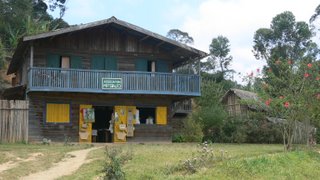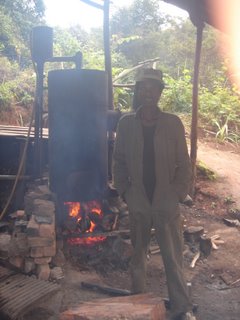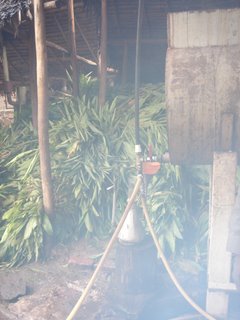Africa, a vast and mysterious continent has always fascinated Westerners. I was no exception to this and having finished my four years at University I started searching for a means to get there and explore. To anyone familiar with internet search engines, the first results were rather disheartening. I could either travel alone, too daunting, travel with a specialist tour operator, too boring, or sign up to a glossy gap-year challenge scheme, too expensive! Although I thoroughly disagree with the concept of paying thousands of pounds to volunteer, these gap challenge schemes did present me with a fantastic idea; why not travel and give something back. With this in mind, I quite randomly met up with an old friend who had recently returned from Madagascar (the only person I know who has been there) and recommended it to me as one of the most beautiful and environmentally diverse countries in the world. With both these ideas in mind, I stumbled across the Dodwell Trust, a charity dedicated to reducing the poverty of one of the world’s poorest countries through education.
Unlike other charities, the Dodwell Trust, does not charge inordinate fees to partake. It is run simply and efficiently by its founder, Christina Dodwell, who deals with every volunteer personally. Having found my means, I signed up, attended a meeting, had a few encounters with some nurse’s with needles then, within a matter of months, I landed in the centre of Madagascar, Antananarivo. It is fair to say, nothing prepares you for your first visit to Africa. It’s a moment you know you will look back on proudly with nostalgia but, at the time, you’re mesmerised and thinking something along the lines of, ‘what am I doing here?’ Believe it or not, that thought quickly fades. In a rickety old Renault 5, I left the airport behind, and shortly pulled up next to the French embassy, opposite to the Trust’s headquarters. Having met the lovely office staff and other volunteers, had a tour of the capital, taught a class of 50 students and sampled the local cuisine at the welcoming lunch, I headed off on an ever-eventful bus journey to Ambositra, my home for a 5 week placement.
The next morning, bathed in brilliant sunshine, the sheer beauty of the place dawned upon me and the other volunteers. As far as the eye can see, the fields are ingeniously quilted in a patchwork of intricately designed irrigation canals, feeding the local crops. The village itself, full of smiling faces leads onto the vibrant market where the intoxicating noise of battering in a blend of Malagasy and French coupled with the smells and sights seems straight out of a movie set. Thoroughly captivated, we spent the remainder of the day being introduced to our students, ranging from a charismatic local police inspector (think Danny Glover) to a group of ten mischievous children, who took great pride in identifying all tourists as ‘vazar’ and then promptly and quite entrepreneurially asking them for a contribution for their school materials. With our classes assigned, the weeks began to fly-by. Despite the cold showers, doxyclicine and ‘culture shock’ we all became accustomed to life at a relaxed African pace. We found the best prices at market, the best cheese from the monastery and, by invitation from the le environnement office, discovered that Malagasy pubs reside in the back of restaurants. Building on these relationships, we were invited to people’s homes, attend local events and participate in a local community that thoroughly welcomed us and appreciated our efforts.
Our efforts were of course, teaching. As concerned as I was by my lack of experience in this, I was amazed at how quickly I adapted to planning and giving lessons. Although (as my fellow volunteers might suggest) I was always first to suggest learning through the ‘academic’ subject of football, I did really enjoy the experience of teaching English; whether this was explaining basic greetings to children or translating common sayings (‘the sharpest tool in the box’) for the local police. Looking back, it was the students themselves that made the teaching so enjoyable. Every lesson, they would engage with a smile and such overwhelming and infectious enthusiasm to learn. Whatever a cliché it may be, and however great the scenery is, this is the part of Madagascar I remember the fondest, the people. I could carry on to write about all the wonderful places I saw, the wildlife, the food I ate, the mis-haps of the infamous public transport, but that would miss the point of this article.
Quite simply, if you want to experience what Madagascar is truly like; if you want to engage and feel part of a Malagasy community then the Dodwell Trust offers you this privileged experience. It is by no means easy, but if you’re prepared to leave the comfort zone of an air-conditioned tour bus, you will see real African culture and a true insight into a timeless and beautifully unspoilt country!
 The Mitsinjo House, our residence for the time we were in Andasibe (this statement is a little misleading.The ground floor room on the left [with the closed shutters] was our house, cosy but comfortable!!). Mama Bozy Nata and family are some of the nicest people you could meet and always good for a laugh.
The Mitsinjo House, our residence for the time we were in Andasibe (this statement is a little misleading.The ground floor room on the left [with the closed shutters] was our house, cosy but comfortable!!). Mama Bozy Nata and family are some of the nicest people you could meet and always good for a laugh. Looking down into Andasibe from the top end of the 'high street'.
Looking down into Andasibe from the top end of the 'high street'. The market, always a fun experience!
The market, always a fun experience! A view towards Andasibe station from the road crossing, outside of the Mitsinjo House. You get used to the ground shaking as the goods trains go through!
A view towards Andasibe station from the road crossing, outside of the Mitsinjo House. You get used to the ground shaking as the goods trains go through! Everyone's favourite, the Parson's chameleon (Calumma parsonii). I beleive this is a male Parson's and is distinguished by the two rather large horns and the overall massive size. Parson's chameleon is a contender for the largest chameleon and can exceed 60cm in length.
Everyone's favourite, the Parson's chameleon (Calumma parsonii). I beleive this is a male Parson's and is distinguished by the two rather large horns and the overall massive size. Parson's chameleon is a contender for the largest chameleon and can exceed 60cm in length. Another contender for the largest chameleon. Oustalet’s chameleon (Furcifer oustaleti) is found in the drier west of Madagascar.
Another contender for the largest chameleon. Oustalet’s chameleon (Furcifer oustaleti) is found in the drier west of Madagascar. At a guess Brookesia superciliaris. Apparently its bad luck to come anywhere near these guys - perhaps that’s why we were ill over Christmas.
At a guess Brookesia superciliaris. Apparently its bad luck to come anywhere near these guys - perhaps that’s why we were ill over Christmas. Male Willsi’s chameleon (Furcifer willsii) with its rather groovy two-pronged head gear and white lipstick.
Male Willsi’s chameleon (Furcifer willsii) with its rather groovy two-pronged head gear and white lipstick. Female Furcifer willsii. Rather pretty dappled effect, don’t you think?
Female Furcifer willsii. Rather pretty dappled effect, don’t you think? This is the oil distillery machine in the MATE (Man and the Environment) NGO Vohimana Rainforest site.
This is the oil distillery machine in the MATE (Man and the Environment) NGO Vohimana Rainforest site. The people in the pictures are the main distillery workers and sometimes have to work night shifts to keep the fire going. Three men work with the distillery, this man to the left works with the distillery machine, another works with the oil produced (such as measuring out in bottles etc) and another collects and chops fire wood to keep the distillery going.
The people in the pictures are the main distillery workers and sometimes have to work night shifts to keep the fire going. Three men work with the distillery, this man to the left works with the distillery machine, another works with the oil produced (such as measuring out in bottles etc) and another collects and chops fire wood to keep the distillery going. Around 140 Kg of leaves from a plant species being used to extract oil from, will make 30ml of oil! The leaves are collected by the local people (mostly women) who live in villages in and around the Vohimana rainforest.
Around 140 Kg of leaves from a plant species being used to extract oil from, will make 30ml of oil! The leaves are collected by the local people (mostly women) who live in villages in and around the Vohimana rainforest.